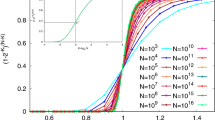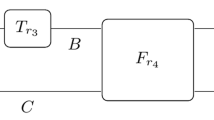Abstract
Non-deterministic polynomial time (commonly termed ‘NP-complete’) problems are relevant to many computational tasks of practical interest—such as the ‘travelling salesman problem’—but are difficult to solve: the computing time grows exponentially with problem size in the worst case. It has recently been shown that these problems exhibit ‘phase boundaries’, across which dramatic changes occur in the computational difficulty and solution character—the problems become easier to solve away from the boundary. Here we report an analytic solution and experimental investigation of the phase transition in K -satisfiability, an archetypal NP-complete problem. Depending on the input parameters, the computing time may grow exponentially or polynomially with problem size; in the former case, we observe a discontinuous transition, whereas in the latter case a continuous (second-order) transition is found. The nature of these transitions may explain the differing computational costs, and suggests directions for improving the efficiency of search algorithms. Similar types of transition should occur in other combinatorial problems and in glassy or granular materials, thereby strengthening the link between computational models and properties of physical systems.
This is a preview of subscription content, access via your institution
Access options
Subscribe to this journal
Receive 51 print issues and online access
$199.00 per year
only $3.90 per issue
Buy this article
- Purchase on Springer Link
- Instant access to full article PDF
Prices may be subject to local taxes which are calculated during checkout




Similar content being viewed by others
References
Cook, S. A. in Proc. 3rd Annu. ACM Symp. on Theory of Computing 151–158 (Assoc. Comput. Machinery, New York, (1971).
Garey, M. & Johnson, D. S. Computers and Intractability: A Guide to the Theory of NP-completeness (Freeman, San Francisco, (1979).
Papadimitriou, C. Computational Complexity (Addison-Wesley, Readings, (1994).
Fu, Y. T. & Anderson, P. W. Application of statistical mechanics to NP-complete problems in combinatorial optimization. J. Phys. A 19, 1605–1620 (1985).
Mézard, M., Parisi, G. & Virasoro, M. A. Spin Glass Theory and Beyond (World Scientific, Singapore, (1987).
Cheeseman, P., Kanefsky, B. & Taylor, W. M. in Proc. 13th Int. Joint Conf. on Artificial Intelligence (IJCAI-91) (eds Mylopoulos, J.&Reiter, R.) 331–337 (Morgan Kaufmann, San Mateo, California, (1991).
Mitchell, D., Selman, B. & Levesque, H. in Proc. 10th Natl. Conf. on Artificial Intelligence (AAAI-92) 440–446 (AAAI Press/MIT Press, Cambridge, Massachusetts, (1992).
Kirkpatrick, S. & Selman, B. Critical behavior in the satisfiability of random Boolean expressions. Science 264, 1297–1301 (1994).
Selman, B., Mitchell, D. & Levesque, H. Generating hard satisfiability problems. Artif. Intell. 81, 17–29 (1996).
Hogg, T., Huberman, B. A. & Williams, C. (eds) Frontiers in problem solving: phase transitions and complexity. Artif. Intell. 81(I&II)(1996).
Hayes, B. Can't get no satisfaction. Am. Sci. 85, 108–112 (1996).
Gross, D. & Mezard, M. The simplest spin glass. Nucl. Phys. B 240, 431–452 (1984).
Aspvall, B., Plass, M. F. & Tarjan, R. E. Alinear-time algorithm for testing the truth of certain quantified Boolean formulas. Inf. Process. Lett. 8, 121–123 (1979).
Goerdt, A. Athreshold for unsatisfiability. J. Comput. System Sci. 53, 469–486 (1996).
Chvàtal, V. & Reed, B. Mick gets some (the odds are on his side). Proc. 33rd IEEE Symp. on Foundations of Computer Science 620–627 (IEEE Computer Soc. Press, New York, (1992).
Friedgut, E. Sharp thresholds of graph properties and the K-SAT problem. J. Am. Math. Soc (in the press).
Beame, P., Karp, R., Pitassi, T. & Saks, M. in Proc. ACM Symp. on Theory of Computing (STOC98) 561–571 (Assoc. Comput. Machinery, New York, (1998).
Monasson, R. & Zecchina, R. Entropy of the K-satisfiability problem. Phys. Rev. Lett. 76, 3881–3885 (1996).
Monasson, R. & Zecchina, R. The statistical mechanics of the random K-satisfiability model. Phys. Rev. E 56, 1357–1370 (1997).
Monasson, R. & Zecchina, R. Tricritical points in random combinatorics: the 2+p SAT case. J. Phys. A 31, 9209–9217 (1998).
Achlioptas, D., Kirousis, L., Kranakis, E. & Krizanc, D. in Proc. Workshop on Randomized Algorithms in Sequential, Parallel and Distributed Computing (RALCOM 97), 1–10 (1998).
Davis, M. & Putnam, H. Acomputing procedure for quantification theory. J. Assoc. Comput. Machinery 7, 201–215 (1960).
Selman, B. & Kirkpatrick, S. Critical behavior in the cost of K-satisfiability. Artif. Intell. 81, 273–295 (1996).
Gomes, C. P., Selman, B. & Crato, N. in Principles and Practice of Constraint Programming (CP97) (ed. Smolka, G.) 121–135 (Lect. Notes in Comput. Sci., Vol. 1330, Springer, Heidelberg, (1997).
Kirkpatrick, T. R., Thirumalai, D. & Wolynes, P. G. Scaling concepts for the dynamics of viscous liquids near an ideal glassy state. Phys. Rev. A 40, 1045–1054 (1989).
Angell, A. C. Formation of glasses from liquids and biopolymers. Science 267, 1924–1935 (1995).
Bouchaud, J.-P., Cates, M. E., Ravi Prakash, J. & Edwards, S. F. Hysteresis and metastability in a continuum sandpile model. Phys. Rev. Lett. 74, 1982–1985 (1995).
Jacobs, D. J. & Thorpe, M. F. Generic rigidity percolation: the pebble game. Phys. Rev. Lett. 75, 4051–4054 (1995).
Moukarzel, C. & Duxbury, P. M. Stressed backbone and elasticity of random central-force systems. Phys. Rev. Lett. 75, 4055–4058 (1995).
Kirkpatrick, S. & Toulouse, G. Configuration space analysis of traveling salesman problems. J. Phys. (France) 46, 1277–1292 (1985).
Schneider, J., Froschhammer, C., Morgenstern, I., Husslein, T. & Singer, J. M. Searching for backbones—an efficient parallel algorithm for the traveling salesman problem. Comput. Phys. Commun. 96, 173–188 (1996).
Kirousis, L., Kranakis, E. & Krizanc, D. in Proc. 4th European Symp. on Algorithms 27–38 (Springer, Berlin, (1996).
Dubois, O. & Boufkhad, Y. Ageneral upper bound for the satisfiability threshold of random K-SAT formulas. J. Algorithms 24, 395–420 (1997).
Kamath, A., Motwani, R., Palem, K. & Spirakis, P. Tail bounds for occupancy and the satisfiability threshold conjecture. Random Struct. Algorithms 7, 59–89 (1995).
Frieze, A. & Suen, S. Analysis of two simple heuristics on a random instance of K-SAT. J. Algorithms 20, 312–335 (1996).
Crawford, J. & Auton, L. in Proc. 11th Natl. Conference on Artificial Intelligence (AAAI-93) 21–27 (AAAI Press/MIT Press, Cambridge, Massachusetts, (1993).
Acknowledgements
S.K. thanks the Laboratories of Theoretical and Statistical Physics at Ecole Normale Superieure for a visiting professorship in 1998, during which this work was completed. B.S. is an Alfred P. Sloan research fellow and is supported by an NSF Faculty Early Career Development Award. During the early phase of this research, B.S. was at AT&T Bell Laboratories.
Author information
Authors and Affiliations
Corresponding author
Rights and permissions
About this article
Cite this article
Monasson, R., Zecchina, R., Kirkpatrick, S. et al. Determining computational complexity from characteristic ‘phase transitions’. Nature 400, 133–137 (1999). https://doi.org/10.1038/22055
Received:
Accepted:
Issue Date:
DOI: https://doi.org/10.1038/22055
This article is cited by
-
Optimizing quantum annealing schedules with Monte Carlo tree search enhanced with neural networks
Nature Machine Intelligence (2022)
-
Task-independent metrics of computational hardness predict human cognitive performance
Scientific Reports (2022)
-
Computational complexity continuum within Ising formulation of NP problems
Communications Physics (2022)
-
Why is Complexity Science valuable for reaching the goals of the UN 2030 Agenda?
Rendiconti Lincei. Scienze Fisiche e Naturali (2021)
-
Easy-hard phase transition in parameter estimation for optical waveguides
Scientific Reports (2020)
Comments
By submitting a comment you agree to abide by our Terms and Community Guidelines. If you find something abusive or that does not comply with our terms or guidelines please flag it as inappropriate.



